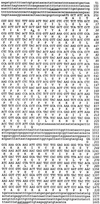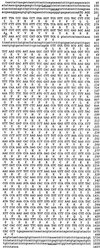Characterization and expression of four proline-rich cell wall protein genes in Arabidopsis encoding two distinct subsets of multiple domain proteins
- PMID: 10594096
- PMCID: PMC59476
- DOI: 10.1104/pp.121.4.1081
Characterization and expression of four proline-rich cell wall protein genes in Arabidopsis encoding two distinct subsets of multiple domain proteins
Abstract
We have characterized the molecular organization and expression of four proline-rich protein genes from Arabidopsis (AtPRPs). These genes predict two classes of cell wall proteins based on DNA sequence identity, repetitive motifs, and domain organization. AtPRP1 and AtPRP3 encode proteins containing an N-terminal PRP-like domain followed by a C-terminal domain that is biased toward P, T, Y, and K. AtPRP2 and AtPRP4 represent a second, novel group of PRP genes that encode two-domain proteins containing a non-repetitive N-terminal domain followed by a PRP-like region rich in P, V, K, and C. Northern hybridization analysis indicated that AtPRP1 and AtPRP3 are exclusively expressed in roots, while transcripts encoding AtPRP2 and AtPRP4 were most abundant in aerial organs of the plant. Histochemical analyses of promoter/beta-glucuronidase fusions localized AtPRP3 expression to regions of the root containing root hairs. AtPRP2 and AtPRP4 expression was detected in expanding leaves, stems, flowers, and siliques. In addition, AtPRP4 expression was detected in stipules and during the early stages of lateral root formation. These studies support a model for involvement of PRPs in specifying cell-type-specific wall structures, and provide the basis for a genetic approach to dissect the function of PRPs during growth and development.
Figures







Similar articles
-
Expression of AtPRP3, a proline-rich structural cell wall protein from Arabidopsis, is regulated by cell-type-specific developmental pathways involved in root hair formation.Plant Physiol. 2000 Mar;122(3):705-14. doi: 10.1104/pp.122.3.705. Plant Physiol. 2000. PMID: 10712533 Free PMC article.
-
Characterization of Phaseolus vulgaris cDNA clones responsive to water deficit: identification of a novel late embryogenesis abundant-like protein.Plant Mol Biol. 1997 Nov;35(4):393-405. doi: 10.1023/a:1005802505731. Plant Mol Biol. 1997. PMID: 9349263
-
PRGL: A cell wall proline-rich protein containning GASA domain in Gerbera hybrida.Sci China C Life Sci. 2008 Jun;51(6):520-5. doi: 10.1007/s11427-008-0067-z. Epub 2008 May 17. Sci China C Life Sci. 2008. PMID: 18488172
-
Proline-rich proteins and glycoproteins: expression of salivary gland multigene families.Biochimie. 1988 Nov;70(11):1689-95. doi: 10.1016/0300-9084(88)90304-5. Biochimie. 1988. PMID: 3149532 Review.
-
Gene Mining for Proline Based Signaling Proteins in Cell Wall of Arabidopsis thaliana.Front Plant Sci. 2017 Feb 27;8:233. doi: 10.3389/fpls.2017.00233. eCollection 2017. Front Plant Sci. 2017. PMID: 28289422 Free PMC article. Review.
Cited by
-
Role of proline in cell wall synthesis and plant development and its implications in plant ontogeny.Front Plant Sci. 2015 Jul 20;6:544. doi: 10.3389/fpls.2015.00544. eCollection 2015. Front Plant Sci. 2015. PMID: 26257754 Free PMC article. Review.
-
WAKs: cell wall-associated kinases linking the cytoplasm to the extracellular matrix.Plant Mol Biol. 2001 Sep;47(1-2):197-206. Plant Mol Biol. 2001. PMID: 11554472
-
A new picture of cell wall protein dynamics in elongating cells of Arabidopsis thaliana: confirmed actors and newcomers.BMC Plant Biol. 2008 Sep 16;8:94. doi: 10.1186/1471-2229-8-94. BMC Plant Biol. 2008. PMID: 18796151 Free PMC article.
-
Genome cluster database. A sequence family analysis platform for Arabidopsis and rice.Plant Physiol. 2005 May;138(1):47-54. doi: 10.1104/pp.104.059048. Plant Physiol. 2005. PMID: 15888677 Free PMC article.
-
Arabidopsis thaliana RALF1 opposes brassinosteroid effects on root cell elongation and lateral root formation.J Exp Bot. 2014 May;65(8):2219-30. doi: 10.1093/jxb/eru099. Epub 2014 Mar 11. J Exp Bot. 2014. PMID: 24620000 Free PMC article.
References
-
- Arsenijevic-Maksimovic I, Broughton WJ, Krause A. Rhizobia modulate root-hair-specific expression of extensin genes. Mol Plant-Microbe Interact. 1997;10:95–101. - PubMed
-
- Bechtold N, Ellis J, Pelletier G. In planta Agrobacterium mediated gene transfer by infiltration of adult Arabidopsis thaliana plants. C R Acad Sci Paris. 1993;316:1194–1199.
-
- Bradley DJ, Kjellbom P, Lamb CJ. Elicitor- and wound-induced oxidative cross-linking of a proline-rich plant cell wall protein: a novel, rapid defense response. Cell. 1992;70:21–30. - PubMed
Publication types
MeSH terms
Substances
LinkOut - more resources
Full Text Sources
Other Literature Sources
Molecular Biology Databases
Research Materials

